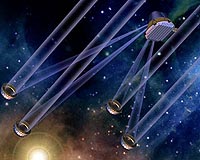 |
Moffett Field CA (SPX) May 14, 2009 NASA's Kepler spacecraft has begun its search for other Earth-like worlds. The mission, which launched from Cape Canaveral, Fla., on March 6, will spend the next three-and-a-half years staring at more than 100,000 stars for telltale signs of planets. Kepler has the unique ability to find planets as small as Earth that orbit sun-like stars at distances where temperatures are right for possible lakes and oceans. "Now the fun begins," said William Borucki, Kepler science principal investigator at NASA's Ames Research Center, Moffett Field, Calif. "We are all really excited to start sorting through the data and discovering the planets." Scientists and engineers have spent the last two months checking out and calibrating the Kepler spacecraft. Data have been collected to characterize the imaging performance as well as the noise level in the measurement electronics. The scientists have constructed the list of targets for the start of the planet search, and this information has been loaded onto the spacecraft. "If Kepler got into a staring contest, it would win," said James Fanson, Kepler project manager at NASA's Jet Propulsion Laboratory, Pasadena, Calif. "The spacecraft is ready to stare intently at the same stars for several years so that it can precisely measure the slightest changes in their brightness caused by planets." Kepler will hunt for planets by looking for periodic dips in the brightness of stars - events that occur when orbiting planets cross in front of their stars and partially block the light. The mission's first finds are expected to be large, gas planets situated close to their stars. Such discoveries could be announced as early as next year. Kepler is a NASA Discovery mission. NASA Ames Research Center, Moffett Field, Calif., is the home organization of the science principal investigator, and is responsible for the ground system development, mission operations and science data analysis. JPL manages the Kepler mission development. Ball Aerospace and Technologies Corp. of Boulder, Colo., is responsible for developing the Kepler flight system and supporting mission operations. Share This Article With Planet Earth
Related Links Kepler mission Lands Beyond Beyond - extra solar planets - news and science Life Beyond Earth
 The Crowded Universe
The Crowded UniverseMoffett Field CA (SPX) May 12, 2009 Planets, planets everywhere. Many have been detected in our cosmic neighborhood, but none of them resemble our own. One planet guru thinks that is about to change. He argues in his new book that we are on the verge of uncovering a universe crowded with Earths. Alan Boss, a research scientist at the Carnegie Institution of Washington, is well-known for his work on theories of planet formati ... read more |
|
| The content herein, unless otherwise known to be public domain, are Copyright 1995-2009 - SpaceDaily. AFP and UPI Wire Stories are copyright Agence France-Presse and United Press International. ESA Portal Reports are copyright European Space Agency. All NASA sourced material is public domain. Additional copyrights may apply in whole or part to other bona fide parties. Advertising does not imply endorsement,agreement or approval of any opinions, statements or information provided by SpaceDaily on any Web page published or hosted by SpaceDaily. Privacy Statement |